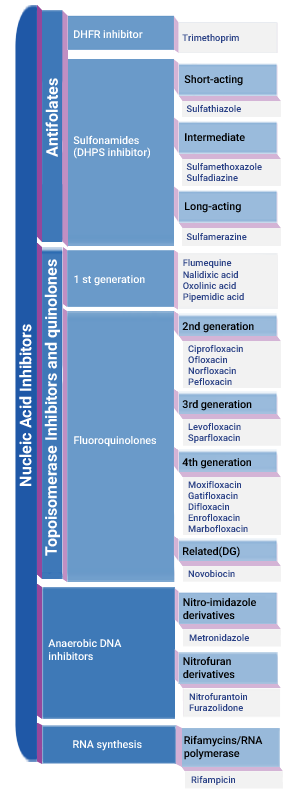Antibiotic Classification and General Information
Protein synthesis inhibitors
Major groups: aminoglycosides, tetracyclines, macrolides
General mechanism of action: Protein synthesis inhibiting antibiotics primarily target the bacterial ribosome (70S) which is made up of a small, 30S subunit and a large, 50S subunit. A ribosome is an essential, complex molecule made up of proteins and RNA and is responsible for synthesizing proteins. Aminoglycosides, macrolides, and other protein synthesis inhibitors target and prevent specific stages of protein synthesis at specific locations on 70S ribosomes. Bacterial death occurs because the cell cannot make proteins required for essential cellular processes.
Effects on humans – Humans, and other eukaryotic cells synthesize proteins using a 80S (not 70S) ribosome which is not targeted by these inhibitors. (other side effects are possible)
Click on any product below for more information.
EF-G
Aminoglycosides
(initiation inhibitors)
Tetracycline antibiotics
(rRNA binding)
Peptidyl
transferase
MLS
(transpeptidation
/tranaslocation)
Steroid Antibacterials
-mycin
(Streptomyces)
-micin
(Micromonospora)
Tetracyclines
Glycylcyclines
Amphenicols
Pleuromutilins
Macrolides
Lincosamides

Nucleic acid synthesis inhibitors
Major groups: Antifolates, topoisomerase inhibitors (floroquinolones)
General mechanism of action: These antibiotics target different stages and pathways of nucleic acid (DNA, RNA…) synthesis. In summary, antifolates (includes sulfonamides) inhibit enzymes involved in folate/folic acid (vitamin B9) synthesis. Folate is an essential ingredient for the synthesis of pyrimidine and purines, two molecules found in nucleotides, the building blocks of DNA and other nucleic acids. Topoisomerase inhibitors prevent DNA replication by inhibiting topoisomerase activity. Toposiomerases are enzymes that relieve DNA supercoil stress during DNA replication. By inhibiting topoisomerase activity, DNA replication is greatly hindered and cell division rate is diminished.
Effects on humans – Humans acquire folate from dietary sources, they do not have a synthesis pathway for folate and are not affected by antifolates in the same way bacteria are. Topoisomerases can be found in human cells; however the molecular makeup of human topoisomerases differs from those found in bacteria. (other side effects are possible)
Click on any product below for more information.
DHFR inhibitor
Sulfonamides
(DHPS inhibitor)
1st generation
Fluoroquinolones
Short-acting
Intermediate
Long-acting
2nd generation
3rd generation
4th generation
Related(DG)
inhibitors
Nitro-imidazole derivatives
Nitrofuran derivatives
Rifamycins/RNA polymerase

Cell wall synthesis inhibitors
Major groups: Beta-lactams (cephalosporins, penicillins)
General mechanism of action: As the name implies, this group of antibiotics inhibits certain stages in bacterial cell wall synthesis. A major structural component in the bacterial cell wall (more so in Gram-positive bacteria) is an essential polymer called peptidoglycan. Beta-lactam antibiotics bind to PBPs or penicillin binding proteins which are involved in the final stages of peptidoglycan synthesis. By inhibiting PBP function, peptidoglycan cannot be properly synthesized and the cell lyses.
Effects on humans – Human cells do not use nor synthesize peptidoglycan and are therefore not susceptible to beta-lactam antibiotics. (other side effects are possible)
Click on any product below for more information.
Penicillins
(penams)
Extended sp.
Narrow sp.
β-lactamase sensitive
β-lactamase resistant
Penems
Carbapenems
Cephalosporins/
Cephamycins
(cephems)
Monobactams
β-lactamase
inhibitors
Combinations
1st
2nd
3rd
4th
Veterinary

